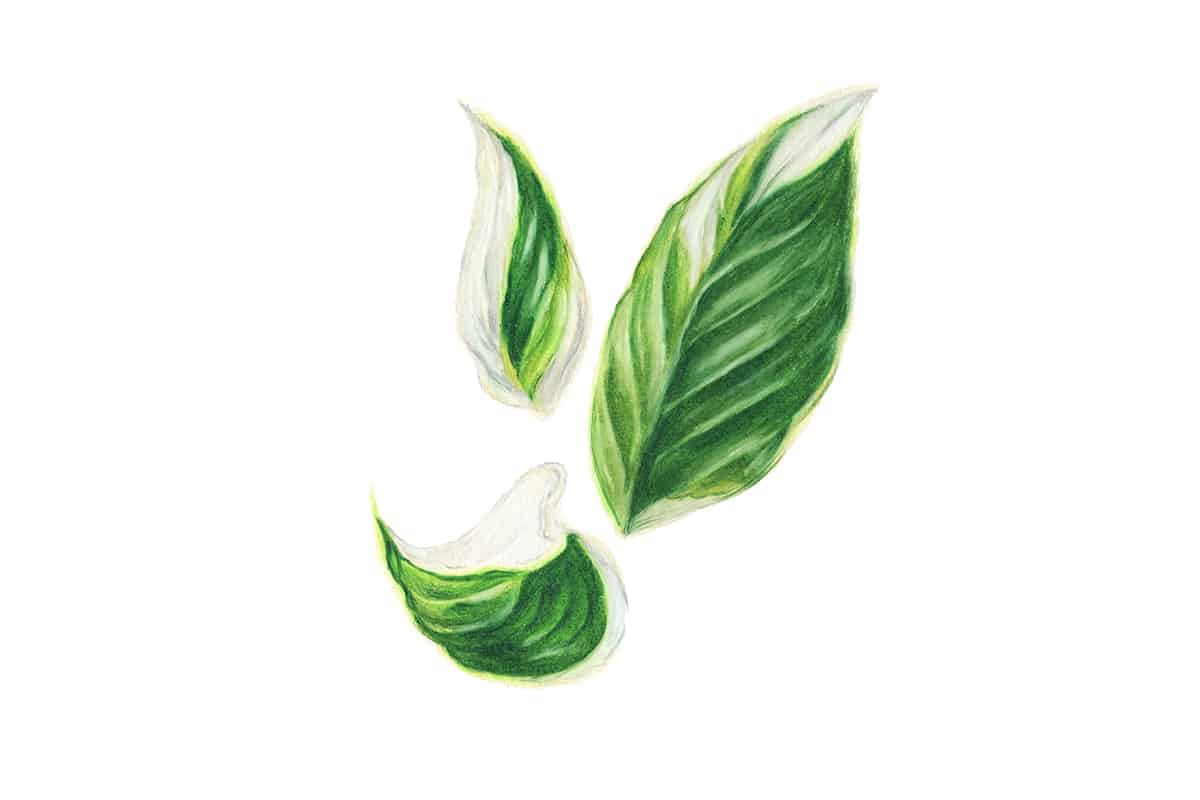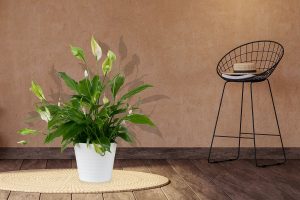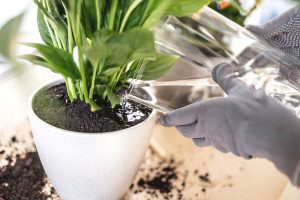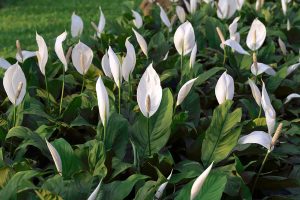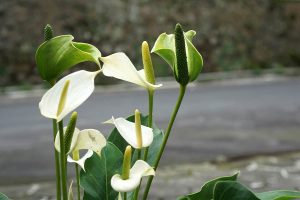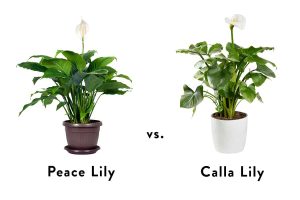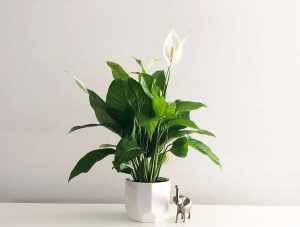The Picasso Peace Lily is a variety of Peace Lily with striking variegation on the leaves. With a dark green base, the foliage features large and irregular splashes of cream, pale mint green, and medium blue-green. This is a tropical native which grows to heights of up to 6 feet in the wild, however, when kept as a houseplant, it more typically tops out at between 1 and 2 feet in height.
The Picasso Peace Lily is among the more sought-after varieties of Peace Lily. While you may not find it at your local nursery, it isn’t too hard to get hold of it online from specialist plant retailers. Here we explain the best ways to care for your Picasso Peace Lily.
| Botanical name | Spathiphyllum ‘Picasso’ |
| Common names | Picasso Peace Lily |
| Plant family | Araceae |
| USDA hardiness zone | 10 and 11 |
| Mature height | 6 feet |
| Mature spread | 4 feet |
Table of Contents
Varieties of Picasso Peace Lily
Domino Peace Lily
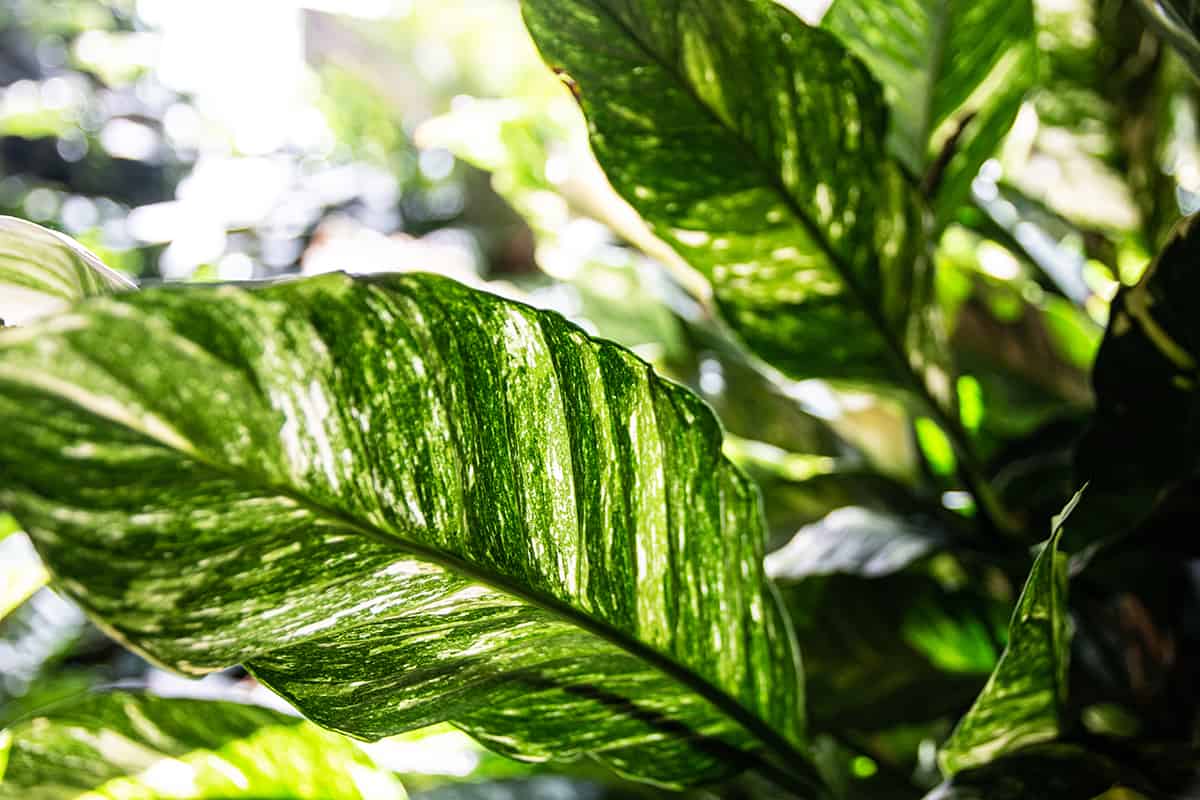
The Domino Peace Lily is another type of variegated Peace Lily, with a more subtle and delicate pattern compared with the Picasso Peace Lily. The foliage of the Domino Peace Lily features delicate flecks of dark green, light green, and cream.
White Stripe Peace Lily
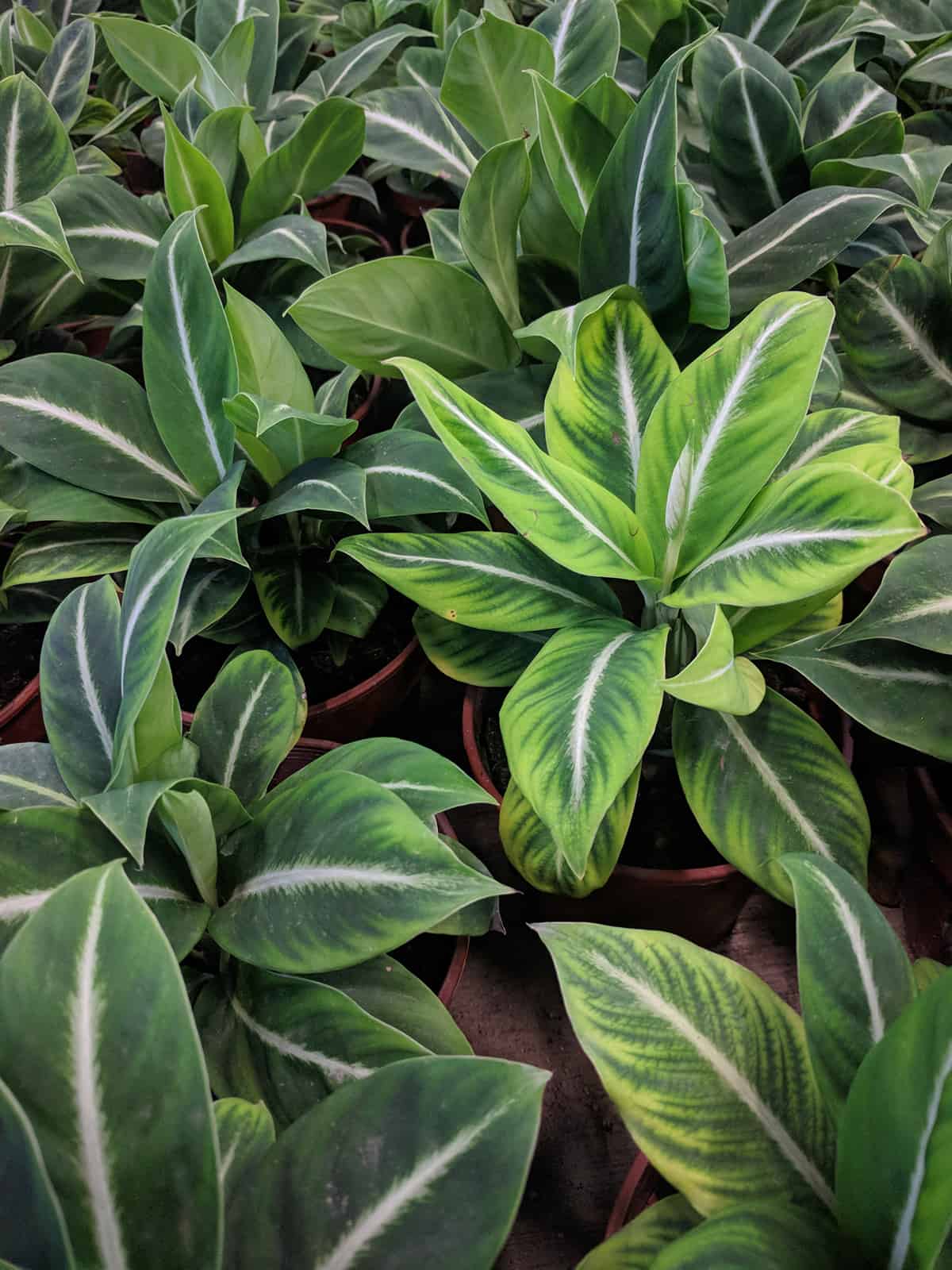
This Peace Lily has a wide white stripe running down the central vein of each leaf and softer white stripes surrounding it. The variegation on this plant is more uniform than that of the Picasso Peace Lily, which has much more random coloring resembling paint splatters.
Picasso Peace Lily Care Tips
Light
Peace Lilies are widely thought of as shade plants because they are able to tolerate low levels of lighting without much trouble. However, this is not correct. While Peace Lilies are capable of surviving on limited amounts of light, they actually thrive best when exposed to bright, indirect light. This is especially the case with variegated varieties of Peace Lilies, such as the Picasso Peace Lily.
Variegated plants of all types require more sunlight than their non-variegated counterparts. This is because chlorophyll, which is required for photosynthesis, is only present in the green parts of the leaves. As a result, variegated plants can struggle to photosynthesize as well as non-variegated plants. Extra sunlight is necessary to help them with this process.
Keep your Picasso Peace Lily in a position where it will receive a minimum of 2 hours of bright indirect light each day, and remember that the more light the plant gets, the better it will grow. An east or west-facing windowsill would be ideal, or you could set the plant in a south-facing aspect if your window has blinds or sheer drapes to help diffuse the light. Avoid putting the Picasso Peace Lily in direct bright light because this can cause the leaves to scorch.
Soil
The Picasso Peace Lily grows best when kept in soil that is moist but not wet. In order for this to happen, the consistency of the soil needs to be able to aid this. You should look for soil that is moderately well-draining in order to avoid the likelihood of root rot, but the soil should not be too sandy or gritty because it will not hold onto enough moisture around the roots. Use a standard houseplant soil designed for leafy or tropical plants, and avoid any soils which are intended for use with cacti or succulents because these will drain too quickly.
Water
Peace Lilies, in general, enjoy a consistent level of moisture, and this is also true for the Picasso Peace Lily. These are fairly thirsty plants, so you can expect to be watering them more than once a week during their growing period. They will not tolerate wet soil or roots in standing water. However, they like for their soil to be kept consistently moist.
This can be a hard balancing act to achieve at first, but once you get used to the needs of the Picasso Peace Lily, it is quite easy because it is so predictable.
A plant pot with drainage holes is essential for a Picasso Peace Lily because this will ensure any excess water is able to drain away from the roots of the plant to prevent root rot. Keep an eye on the condition of the top layer of soil on your plant because as soon as this starts to appear dry, then it is time to add more water.
If the leaves of your Picasso Peace Lily start to droop or wilt, this is a sure sign that you have allowed the soil to get too dry. You can revive your plant by giving it a generous helping of water, but try to avoid the soil drying out in the future because repeatedly wilting leaves can damage the health of the Picasso Peace Lily.
The water you use will make a difference to the health of your plant. The Picasso Peace Lily is sensitive to minerals or additives in water such as fluoride and chlorine, and a build-up of this in the soil can burn the roots of the plants and cause growth issues. To avoid this, use rainwater or filtered water when watering your Picasso Peace Lily.
Temperature
The Picasso Peace Lily is not frost-hardy and should not be grown outdoors outside of USDA hardiness zones 10 and 11. When growing the plant outside, it should be planted directly into the soil in the ground. This is because its roots are very susceptible to damage from the cold, and they will be better insulated in the ground as opposed to in an outdoor pot.
If your Picasso Peace Lily is growing in an outdoor pot, use bubble wrap or gardener felt sheeting to insulate the pot through the cooler months to avoid root damage. Once a Peace Lily has suffered from low temperatures at the roots, it is rarely able to survive for much longer.
The Picasso Peace Lily is ideal for growing as a houseplant because it is accustomed to warm temperatures of around 70°F in its native environment, and this is the typical temperature of most homes. You can expect that if the temperature in your home is comfortable enough for yourself and your family, then it will also be suitable for your Picasso Peace Lily.
Humidity
The Picasso Peace Lily grows natively along the ground of rainforests, where rainfall and humidity are high. If you want to emulate the conditions of the plant’s natural environment, keep it in a room that has high humidity levels, such as the bathroom or kitchen. These rooms have more moisture in the air compared to other rooms because of the use of showers, bathtubs, and kitchen faucets.
In an ideal world, the Picasso Peace Lily would be kept in an area where humidity levels were between 70 and 80%; however, it is very tolerant of lower humidity levels down to around 30% humidity. If you want to keep your Picasso Peace Lily happy, you can mist the leaves every few days with a water spray or use an electric humidifier.
Some houseplant parents like to keep their humidity-loving plants inside cabinets with glass doors, as these work like greenhouses to let light in while keeping humidity high.
Fertilizer
The Picasso Peace Lily receives very little in the way of nutrition in its natural habitat. This means that it will survive just fine without fertilizer when kept as a houseplant.
If you wish to add fertilizer to your Picasso Peace Lily, use a balanced formula that has been diluted. Too much nitrogen will result in lush foliage but to the detriment of the flowers, which require phosphorus to bloom.
Picasso Peace Lily FAQs
Are Picasso Peace Lilies toxic?
Yes, like other varieties of Peace Lily, the Picasso Peace Lily is toxic. It contains calcium oxalate crystals in every part of the plant, which are tiny needle-sharp fragments that produce very unpleasant side effects when ingested. Both pets and humans, such as inquisitive children, should be kept well away from this plant. Symptoms that may arise from ingesting any part of the plant include inflammation, diarrhea, excessive drooling, vomiting, and trouble breathing.
Are Picasso Peace Lilies easy to grow?
Picasso Peace Lilies are easy-care plants as long as you know what you’re doing. They are not as tolerant of low light as the non-variegated Peace Lilies, and they require attentive watering. However, they rebound well from mistreatment and can grow in a range of humidity levels.
Are Picasso Peace Lilies resistant to pests?
Picasso Peace Lilies do not commonly suffer from a particular pest infestation, but they are not resistant to pests. Ensuring your plant is cared for properly to keep it strong and healthy will help to deter potential pests, though unfortunately, spider mites and fungus gnats are common problems with plants that enjoy moist soil and high levels of humidity because these are conditions where the pests thrive.
